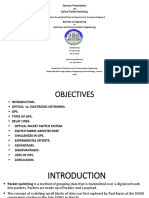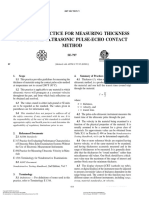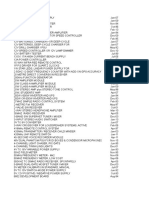0 ratings0% found this document useful (0 votes)
163 viewsSpread Spectrum
Spread Spectrum
Uploaded by
mohan inumarthiThe document discusses spread spectrum modulation techniques. It describes how a signal is modulated using a spreading code to increase its bandwidth before transmission. At the receiver, the same code is used to demodulate the spread spectrum signal and recover the original data. Two common techniques are described: direct sequence spread spectrum which multiplies the data by a pseudo-random code, and frequency hopping spread spectrum which rapidly switches the carrier frequency. The document outlines the operation and advantages of these methods.
Copyright:
© All Rights Reserved
Available Formats
Download as PDF, TXT or read online from Scribd
Spread Spectrum
Spread Spectrum
Uploaded by
mohan inumarthi0 ratings0% found this document useful (0 votes)
163 views41 pagesThe document discusses spread spectrum modulation techniques. It describes how a signal is modulated using a spreading code to increase its bandwidth before transmission. At the receiver, the same code is used to demodulate the spread spectrum signal and recover the original data. Two common techniques are described: direct sequence spread spectrum which multiplies the data by a pseudo-random code, and frequency hopping spread spectrum which rapidly switches the carrier frequency. The document outlines the operation and advantages of these methods.
Original Description:
DIGITAL COMMUNICATIONS
Original Title
SPREAD SPECTRUM
Copyright
© © All Rights Reserved
Available Formats
PDF, TXT or read online from Scribd
Share this document
Did you find this document useful?
Is this content inappropriate?
The document discusses spread spectrum modulation techniques. It describes how a signal is modulated using a spreading code to increase its bandwidth before transmission. At the receiver, the same code is used to demodulate the spread spectrum signal and recover the original data. Two common techniques are described: direct sequence spread spectrum which multiplies the data by a pseudo-random code, and frequency hopping spread spectrum which rapidly switches the carrier frequency. The document outlines the operation and advantages of these methods.
Copyright:
© All Rights Reserved
Available Formats
Download as PDF, TXT or read online from Scribd
Download as pdf or txt
0 ratings0% found this document useful (0 votes)
163 views41 pagesSpread Spectrum
Spread Spectrum
Uploaded by
mohan inumarthiThe document discusses spread spectrum modulation techniques. It describes how a signal is modulated using a spreading code to increase its bandwidth before transmission. At the receiver, the same code is used to demodulate the spread spectrum signal and recover the original data. Two common techniques are described: direct sequence spread spectrum which multiplies the data by a pseudo-random code, and frequency hopping spread spectrum which rapidly switches the carrier frequency. The document outlines the operation and advantages of these methods.
Copyright:
© All Rights Reserved
Available Formats
Download as PDF, TXT or read online from Scribd
Download as pdf or txt
You are on page 1of 41
UNIT – V
Spread Spectrum Modulation
Spread Spectrum
• Input is fed into a channel encoder
– Produces analog signal with narrow bandwidth
• Signal is further modulated using sequence of digits
– Spreading code or spreading sequence
– Generated by pseudo noise, or pseudo-random number generator
• Effect of modulation is to increase bandwidth of signal to be
transmitted.
• On receiving end, digit sequence is used to demodulate the
spread spectrum signal.
• Signal is fed into a channel decoder to recover data.
Spread Spectrum
PN (Pseudo Noise or Pseudo Random)Sequences
• PN generator produces periodic sequence that appears to be
random.
• Shift register consists of ‘m’ flip-flops(FF), data from one FF
shifts to next whenever clock pulse is applied.
• The PN sequence is generated at the output of last FF.
Figure: Feedback shift register to generate pseudo-noise sequences
• Length (N)of PN sequence is 2m-1, where m is
the number of flip-flops.
N = 2m-1
• PN sequence is also known as maximum length
sequence.
• Duration of each bit in PN sequence is known
as chip (Tc).
• Period of PN sequence, Tb = NTc
• Rc is the chip rate (chips per second), Rc = 1/ Tc
(b) PN sequence c(t)
Properties of PN Sequences
1. Balance Property: No. of 1’s is always one more than
no. of 0’s in each period of a PN sequence.
2. Run Property: Run means subsequence of identical
symbols i.e., 1’s or 0’s.
– ½ of the runs of length 1
– ¼ of the runs of length 2
– 1/8 of the runs of length 3 ……
3. Correlation Property: The autocorrelation function of
PN sequence is periodic and binary valued.
Autocorrelation of PN sequence (Rc(τ))
Shift register stages, m Feedback taps
2 (2,1)
3 (3,1)
4 (4,1)
5 (5,2); (5,4,3,2); (5,4,2,1)
6 (6,1); (6,5,2,1); (6,5,3,2)
… …
… …
Table: Feedback taps for shift registers up to 6 stages
Direct Sequence Spread Spectrum (DS-SS)with Coherent
BPSK
• DS-SS BPSK Transmitter:
• Binary data bk is given to NRZ level encoder to obtain bipolar NRZ
sequence, b(t).
• Pseudo noise sequence generator generates PN sequence c(t) and is
multiplied with b(t) to produce direct sequence spread signal m(t).
• BPSK modulator modulates m(t) with the carrier signal φ(t) and
generates output signal x(t).
Direct Sequence Spread Spectrum (DS-SS)with
Coherent BPSK
• DS-SS BPSK Receiver:
• DS-SS BPSK Receiver:
• Received signal y(t) is multiplied with the carrier signal
and the product signal is then passed through a LPF to
produce m^(t). (The bandwidth of LPF is equal to that
of m(t)).
• This signal is applied to the second demodulator which
despreads the signal.
• The integrator integrates the product of the detected
message signal and pseudo noise signal over one bit
period, Tb.
• The decision is then taken depending up on the polarity
of output (v) of the integrator.
Performance of Direct Sequence Spread
Spectrum system
1. Processing Gain (PG): PG is defined as the ratio the
bandwidth of spread message signal to the bandwidth
of unspreaded data signal.
2. Probability of error of DS/BPSK System:
3. Jamming Margin:
Ranging using DS-SS
Ranging using DS-SS
Frequency Hop Spread Spectrum (FH-SS)
• Frequency hopping means to transmit the data bits in
different frequency slots.
• The total bandwidth of the output signal is equal to the
sum of all these frequency slots or hops.
• Hop rate (Rh): The rate of change of frequency hops.
• Symbol rate (Rs): the rate at which k-bit symbols of data
input sequence are generated.
• Types of frequency hopping:
– Slow Frequency hopping
– Fast Frequency hopping
Slow Frequency Hopping
• When several symbols of data are transmitted in one
frequency hop, then it is called slow frequency
hopping.
• One frequency hop = Several symbols are transmitted
• Rh < Rs
• M-ary FSK is used along with frequency hop spread
spectrum.
• ‘k’ successive bits of input sequence represent 2k = M
symbols.
• Those M distinct symbols are transmitted with the help
of M-ary FSK modulation.
Transmitter of FH/MFSK System
Transmitter of FH/MFSK System
• The input binary sequence is applied to the M-ary FSK modulator. The
modulator output is the particular frequency (out of M frequencies)
depending upon the input symbol.
• The output of FSK modulator is then applied to the mixer. The other i/p
to mixer is particular frequency from frequency synthesizer.
• The o/p of mixer is the sum frequency component of FSK signal and
frequency hop, known as FH/MFSK signal.
• The i/ps of frequency synthesizer are controlled by PN sequence
generator.
• The ‘t’ successive bits of PN sequence generator control the frequency
hops generated by the synthesizer.
• Since the bits of PN sequence generator change randomly, the frequency
hops generated also change randomly.
Receiver of FH/MFSK System
Receiver of FH/MFSK System
• The received FH/MFSK signal is applied to the mixer along with
the synthesizer output.
• The sum and difference frequencies are generated by the mixer.
Only difference frequencies are allowed to pass the mixer, which
are exactly M-ary FSK signals.
• These signals are given to the non-coherent M-ary FSK detector
which detects the symbols transmitted.
Example of slow frequency hopping
1. In the fig., 3 bits of PN sequence are used to select a hop i.e.,
there are 23 = 8 hops over complete bandwidth.
2. Two bits of i/p data represent one symbol. Here, two symbols
are transmitted on one frequency hop.
3. There will be total M=22=4 symbols. Thus in a single hop,
there are 4 different frequencies that correspond to 4 different
symbols.
4. In fig., two symbols can occupy any two frequencies in one
hop out of four.
5. The symbol 01 has FSK frequency of f2. and because of
frequency hopping this frequency is increased to fH+f2.
6. Symbol 11 has frequency of fH+f4. The hop frequency fH is
controlled by bits of PN sequence.
Fast Frequency Hopping
• When several frequency hops are used to transmit one
symbol, then it is called fast frequency hopping.
• Several frequency hops = One symbol transmitted
• Rh > Rs
• Advantage of fast frequency hopping is that, before
the jammer tries to complete reception of one symbol,
carrier frequency changes.
Example of Fast Frequency Hopping
Example of Fast Frequency Hopping
1. The first two bits 01 of i/p binary data form one
symbol (since bits per symbol are two).
2. Two hops are used to transmit one symbol.
3. As shown in figure, the frequency of FSK signal for
symbol 01 is f2. this symbol is transmitted in first
hop (fH1+f2) and also in other hop (fH6+f2).
Comparison of slow and fast frequency hopping
Synchronization in spread spectrum systems
1. Spread spectrum systems are essentially synchronous. The
pseudo noise sequences generated at the receiver and
transmitter must be the same and locked to each other.
2. The synchronization of the spread spectrum systems can
be considered in two parts: Acquisition and tracking.
3. Acquisition means initial synchronization of the spread
spectrum signal.
4. Tracking starts after acquisition is complete. Acquisition
is also called as coarse synchronization and tracking is
called as fine synchronization.
Acquisition of DS Signal using Serial Search
• It is based on the serial search concept.
• The received signal is correlated with the generated PN
sequence over the time interval NTc.
• The o/p of correlator is compared with a threshold.
• If it exceeds the threshold, then the required
signal is obtained.
• If it does not exceed, the PN generator o/p is
advanced by half chip duration and correlation
is performed.
• The o/p of correlator is again compared with
the threshold and the procedure is repeated.
Acquisition of DS Signal using Serial Search
• The VCO consists of frequency synthesizer, PN
generator and clock generator.
• The tuned filter passes only the intermediate frequency
f0.
• The envelope detector generates the output which is
compared with the threshold voltage.
• When the i/p frequency and frequency of VCO are
same, the o/p of threshold detector is high and the
clock generator starts running continuously.
• Then the signal is said to have acquired and the
tracking starts.
Comparison of Spread Spectrum Methods
Comparison of Spread Spectrum Methods
Applications of Spread Spectrum Modulation
1. Anti-jamming for military applications
2. Low probability of intercept
3. Mobile communications
4. Secured communications
5. Distance measurements
6. Selective calling
7. CDMA communication
You might also like
- Adc Mod 4Document130 pagesAdc Mod 4anuNo ratings yet
- CT2 - Unit3 - Question BankDocument3 pagesCT2 - Unit3 - Question BankJagrit DusejaNo ratings yet
- Small-Scale Multipath Measurements Lecture NotesDocument6 pagesSmall-Scale Multipath Measurements Lecture NotesRajashekhar KNo ratings yet
- SECTION 4 - RF System DesignDocument44 pagesSECTION 4 - RF System DesignBelachew AndualemNo ratings yet
- Experiment No. (1) Optical Fiber Communication System: ObjectDocument13 pagesExperiment No. (1) Optical Fiber Communication System: ObjectFaez FawwazNo ratings yet
- Types of NON-COCHANNEL INTERFERENCEDocument1 pageTypes of NON-COCHANNEL INTERFERENCEroyfadliNo ratings yet
- Coding Techniques Important Questions-1Document6 pagesCoding Techniques Important Questions-1jaya Sekhar lankelaNo ratings yet
- Chapter 12 Wireless Sensor Networks: From Reference Book: Adhoc Wireless Networks By: B.S. ManojDocument42 pagesChapter 12 Wireless Sensor Networks: From Reference Book: Adhoc Wireless Networks By: B.S. ManojMounisha g bNo ratings yet
- Dcom Mod4Document4 pagesDcom Mod4Vidit shahNo ratings yet
- Digital Modulation Technique (U-2)Document82 pagesDigital Modulation Technique (U-2)lakshmikanth gNo ratings yet
- Ece-V-Information Theory & Coding (10ec55) - AssignmentDocument10 pagesEce-V-Information Theory & Coding (10ec55) - AssignmentLavanya Vaishnavi D.A.No ratings yet
- Seminar Presentation On Optical Packet Switching.: Bachelor of Engineering in Electronic and Communication EngineeringDocument25 pagesSeminar Presentation On Optical Packet Switching.: Bachelor of Engineering in Electronic and Communication Engineeringsimranjeet singhNo ratings yet
- A Synchronous Data TransferDocument10 pagesA Synchronous Data Transfersmadi13No ratings yet
- Radar BitsDocument2 pagesRadar Bitsvenkiscribd444No ratings yet
- DC Lab VivaDocument5 pagesDC Lab VivaAbir HoqueNo ratings yet
- Chapter One: Review of Digital Communication SystemsDocument26 pagesChapter One: Review of Digital Communication SystemsYes Mu So ManNo ratings yet
- Digital To Analog ConversionDocument15 pagesDigital To Analog ConversionAbdul RaufNo ratings yet
- Vlsi Imlememt of OdfmDocument10 pagesVlsi Imlememt of OdfmShrey MalikNo ratings yet
- PSD of Pulse Coding Techniques With MatlabDocument7 pagesPSD of Pulse Coding Techniques With MatlabNithin MukeshNo ratings yet
- Performance Analysis of Higher Order ModulationDocument30 pagesPerformance Analysis of Higher Order ModulationMintesnot HamleNo ratings yet
- Laser MetrologyDocument41 pagesLaser MetrologyjennybunnyomgNo ratings yet
- 22425-2022-Winter-Model-Answer-Paper (Msbte Study Resources)Document29 pages22425-2022-Winter-Model-Answer-Paper (Msbte Study Resources)Suraj ShahNo ratings yet
- Binary Erasure Channel (BEC)Document2 pagesBinary Erasure Channel (BEC)Anonymous JXTwISptYANo ratings yet
- Cellular ConceptDocument27 pagesCellular ConceptAsit Panda100% (2)
- Microwave Devices and CircuitsDocument274 pagesMicrowave Devices and CircuitsEndale Gezahgn100% (1)
- DSP CEN352 Ch2 SamplingDocument29 pagesDSP CEN352 Ch2 SamplingTewodrosNo ratings yet
- EENG473 Mobile Communications Module 2: Week # (4) : The Cellular Concept - System Design FundamentalsDocument22 pagesEENG473 Mobile Communications Module 2: Week # (4) : The Cellular Concept - System Design FundamentalsAnoop K. MishraNo ratings yet
- LTI Systems As A Frequency Selective FiltersDocument12 pagesLTI Systems As A Frequency Selective FiltersAyesha MughalNo ratings yet
- Unit 3 - WSN - MACDocument22 pagesUnit 3 - WSN - MACRmkumarsNo ratings yet
- Experiment no. 2 Aim: - Theory: c1 (t) = √2/Tb cos 2πƒ1tDocument6 pagesExperiment no. 2 Aim: - Theory: c1 (t) = √2/Tb cos 2πƒ1tMudit GoelNo ratings yet
- Basics of Switching SystemDocument6 pagesBasics of Switching SystemSoumitra BhowmickNo ratings yet
- Analog and Digital Communication SyllabusDocument3 pagesAnalog and Digital Communication SyllabusSrinivas SamalNo ratings yet
- Chapter5 NETWORK LAYERDocument86 pagesChapter5 NETWORK LAYERmuniNo ratings yet
- Sample Question Paper Applied ElectronicsDocument4 pagesSample Question Paper Applied Electronicssachin barge100% (1)
- MTSODocument23 pagesMTSOShreya ShekarNo ratings yet
- MP3 PlayerDocument8 pagesMP3 PlayerHaider AbbasNo ratings yet
- L31-Microwave TransistorsDocument14 pagesL31-Microwave TransistorsMohamed shabanaNo ratings yet
- Kell Factor ExplanationDocument9 pagesKell Factor Explanationநட்ராஜ் நாதன்100% (1)
- Accident Statistics, Buzzer During Any AccidentDocument30 pagesAccident Statistics, Buzzer During Any Accidentpray1979567% (6)
- Digital Integrated Circuits: A Design PerspectiveDocument78 pagesDigital Integrated Circuits: A Design Perspectiveapi-127299018No ratings yet
- Digital Communication Lab: Internal Lab Exam-QuestionsDocument4 pagesDigital Communication Lab: Internal Lab Exam-Questionsalwin9185No ratings yet
- Communication SystemsDocument16 pagesCommunication SystemsLakshmiNo ratings yet
- R-22 Eca Lab ManualDocument59 pagesR-22 Eca Lab ManualGovardhan NunetiNo ratings yet
- ECE4313 Worksheet EndsemDocument5 pagesECE4313 Worksheet EndsemBereketeab ZinabuNo ratings yet
- CN 001 TSDocument32 pagesCN 001 TSoselopzaNo ratings yet
- PCM Noise and CompandingDocument15 pagesPCM Noise and Compandingwoody0No ratings yet
- Switching System: University of DhakaDocument27 pagesSwitching System: University of DhakaAlamgir Kabir ShuvoNo ratings yet
- Unit II 2 MarksDocument6 pagesUnit II 2 MarksGowthamanNo ratings yet
- Module 1 Part 2: Input/Output OrganizationDocument50 pagesModule 1 Part 2: Input/Output Organizations8102003No ratings yet
- IoT One Mark Questions With AnswersDocument6 pagesIoT One Mark Questions With Answerssairahulsaggurthi100% (1)
- Data Communication EquipmentDocument6 pagesData Communication EquipmentCarlo Guzon100% (1)
- Experiment 6 Implementation of LP Fir Filter For A Given SequenceDocument25 pagesExperiment 6 Implementation of LP Fir Filter For A Given SequenceSrinivas SamalNo ratings yet
- Channel Assignment Strategies, Handoff Strategies Improvement inDocument37 pagesChannel Assignment Strategies, Handoff Strategies Improvement inHarpuneet SinghNo ratings yet
- Ec51 Digital CommunicationDocument18 pagesEc51 Digital CommunicationvijayprasathmeNo ratings yet
- Unit IV Optical, Pressure and Temperature SensorsDocument41 pagesUnit IV Optical, Pressure and Temperature SensorsAlemeNo ratings yet
- Need For Modulation in Communications SystemDocument4 pagesNeed For Modulation in Communications Systemsnanm71% (7)
- Digital CommunicationDocument19 pagesDigital Communicationnimish kambleNo ratings yet
- Tutorial 3 - Ecm 620 - Chapter 3 - Latest - Dr. NosuzilaDocument37 pagesTutorial 3 - Ecm 620 - Chapter 3 - Latest - Dr. NosuzilaAzeem Aiman100% (1)
- Wireless Medium Access Control & CDMA Based CommunicationDocument9 pagesWireless Medium Access Control & CDMA Based CommunicationMahesh B RaghunandanNo ratings yet
- 8IT01 UNIT III Spread Spectrum SignalsDocument54 pages8IT01 UNIT III Spread Spectrum SignalspvingoleNo ratings yet
- LCS Assignment1 - 18 19 PDFDocument2 pagesLCS Assignment1 - 18 19 PDFmohan inumarthiNo ratings yet
- LCS Assignment1 - 18 19 PDFDocument2 pagesLCS Assignment1 - 18 19 PDFmohan inumarthiNo ratings yet
- JEE Main 2019 Paper 1 Question Paper & Answer Key - January 10, Shift 2Document42 pagesJEE Main 2019 Paper 1 Question Paper & Answer Key - January 10, Shift 2mohan inumarthiNo ratings yet
- Digital To Analog Converters: Andrew Gardner Muhammad Salman David Fernandes Jevawn RobertsDocument35 pagesDigital To Analog Converters: Andrew Gardner Muhammad Salman David Fernandes Jevawn Robertsmohan inumarthiNo ratings yet
- Gokaraju Rangaraju Institute of Engineering and Technology: Part-B (3 5 15M)Document2 pagesGokaraju Rangaraju Institute of Engineering and Technology: Part-B (3 5 15M)mohan inumarthiNo ratings yet
- Write Short Notes On Travelling Wave Antenna? AnsDocument13 pagesWrite Short Notes On Travelling Wave Antenna? Ansmohan inumarthiNo ratings yet
- UNIT 3 - Part2Document18 pagesUNIT 3 - Part2mohan inumarthiNo ratings yet
- Awp NotesDocument5 pagesAwp Notesmohan inumarthiNo ratings yet
- Unit 2Document16 pagesUnit 2mohan inumarthiNo ratings yet
- Explain The Radiation From Two-Wire. Ans:: Unit 1Document13 pagesExplain The Radiation From Two-Wire. Ans:: Unit 1mohan inumarthiNo ratings yet
- Scanned by CamscannerDocument2 pagesScanned by Camscannermohan inumarthiNo ratings yet
- A 0.0285-mm2 0.68-pJ Bit Single-Loop Full-Rate Bang-Bang CDR Without Reference and Separate FD Pulling Off An 8.2-Gb S S Acquisition Speed of The PAM-4 Input in 28-nm CMOSDocument16 pagesA 0.0285-mm2 0.68-pJ Bit Single-Loop Full-Rate Bang-Bang CDR Without Reference and Separate FD Pulling Off An 8.2-Gb S S Acquisition Speed of The PAM-4 Input in 28-nm CMOSMinh KhangNo ratings yet
- CRDocument6 pagesCRDiego IgnácioNo ratings yet
- Intro To DigiCom IIDocument81 pagesIntro To DigiCom IIAnonymous FKMfvCbNo ratings yet
- FM DemodulatorDocument8 pagesFM DemodulatorYash BudhwarNo ratings yet
- B.Tech 3 Semester MATH-201 E Mathematics - IiiDocument19 pagesB.Tech 3 Semester MATH-201 E Mathematics - IiiTinkal SharmaNo ratings yet
- Fdci221-Fdcio221 A6v10248337Document8 pagesFdci221-Fdcio221 A6v10248337Sze WalterNo ratings yet
- ST2207 TDMDocument18 pagesST2207 TDMAbhay GargNo ratings yet
- PGCET Electronics Question Paper 1Document2 pagesPGCET Electronics Question Paper 1yerale2515No ratings yet
- Emi Total MaterialDocument149 pagesEmi Total Materialtriveni dronadulaNo ratings yet
- AmDocument8 pagesAmLisa TorresNo ratings yet
- Se 797Document7 pagesSe 797donaldoguerreroNo ratings yet
- E85001-0241 - Input Modules PDFDocument4 pagesE85001-0241 - Input Modules PDFarun RajannaNo ratings yet
- VDF Robicom Siemens PDFDocument265 pagesVDF Robicom Siemens PDFFernando NoriegaNo ratings yet
- BXE Notes Unit VI - Communication SystemsDocument20 pagesBXE Notes Unit VI - Communication SystemsRohit AhireNo ratings yet
- LLZ PracticeDocument82 pagesLLZ PracticeChiranjivi KuthumiNo ratings yet
- ScottBaxter RF100Document438 pagesScottBaxter RF100prashant_bankarNo ratings yet
- VT Fuze PDFDocument26 pagesVT Fuze PDFLG GL100% (1)
- Acs - Analog Communication Systems ManualDocument56 pagesAcs - Analog Communication Systems ManualAmandeep SinghNo ratings yet
- Question BankDocument6 pagesQuestion Banksweetkhushboo786_592No ratings yet
- GBD PlusDocument2 pagesGBD PlusseinnationalNo ratings yet
- Epe IndexDocument94 pagesEpe IndexMilton AlvesNo ratings yet
- Chapter 2 Analogue Modulation - Jun2019Document61 pagesChapter 2 Analogue Modulation - Jun2019ElveronNo ratings yet
- Beacon 110 Gas Monitor Operator's Manual: Part Number: 71-0110RK Revision: 0 Released: 12/8/08Document42 pagesBeacon 110 Gas Monitor Operator's Manual: Part Number: 71-0110RK Revision: 0 Released: 12/8/08Ahmed GhreebNo ratings yet
- Loop Detector Documentation PDFDocument11 pagesLoop Detector Documentation PDFBaciu Vlad-Eusebiu100% (2)
- CATU CC 365 Standard Electronic Voltage DetectorDocument1 pageCATU CC 365 Standard Electronic Voltage DetectorMarcio NunesNo ratings yet
- J 506Document36 pagesJ 506Dan MircescuNo ratings yet
- Frequency Shift Keying PPT Final But Not FinishedDocument24 pagesFrequency Shift Keying PPT Final But Not FinishedCarmie Basillote Bulala100% (2)
- HUKINGS Solid State Microwave Generator Data Sheet-HSMG-2450MHz-200WDocument2 pagesHUKINGS Solid State Microwave Generator Data Sheet-HSMG-2450MHz-200WkingNo ratings yet
- A 5.0-To-12.5-Gb S 1.7-pJ B 0.66-s Lock-Time Reference-Less Sub-Sampling CDR With Beat Detection FLL in 28nm CMOSDocument3 pagesA 5.0-To-12.5-Gb S 1.7-pJ B 0.66-s Lock-Time Reference-Less Sub-Sampling CDR With Beat Detection FLL in 28nm CMOSMinh KhangNo ratings yet



































































































